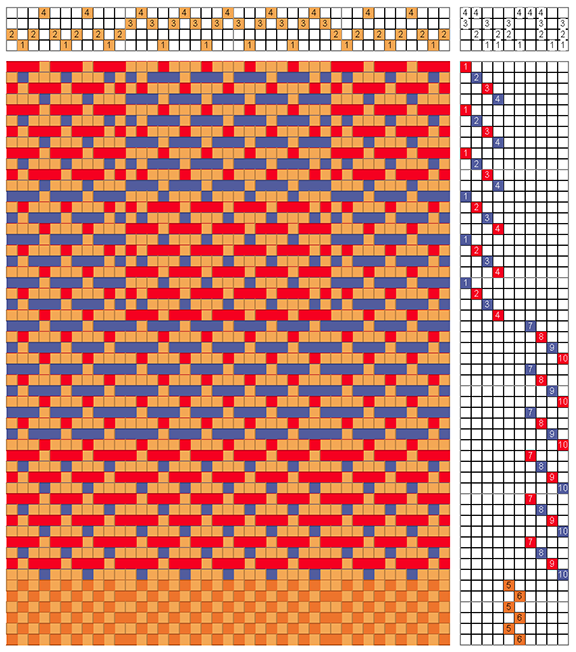Double Binding Technique for Rag Rugs
Marcy Petrini
1/25/2016
In 2014, I was fortunate enough to visit the Casa das Tecedeiras (Weavers’ House) in Janeiro de Cima, one of the Schist Villages in the Serra da Estrela mountain range, in Central Portugal. While a lot of the traditional weaving is no longer done on a regular basis in the village, various rag rugs are pretty common in Portugal and those from Janeiro de Cima are typically woven using a double binding technique. At the Weavers’ House we saw several being woven and we learned about the technique. (I co-author an article in Shuttle Spindle & Dyepot about the fiber traditions of Portugal, Spring 2015, 36-40).
Once home, I set up a sampler to practice what I learned in preparation of writing the article. Since then I used the technique to weave a rug with fleece weft, and now I am returning to its tradition: I have a warp on the loom to weave a rag rug.
On four shafts, the threading has two blocks, each of which can be repeated as long as desired, since the floats are limited; three threads are used in the transition from one block to the other. In weaving, two wefts are used: on one side, one weft is shown in one block, the other in the second block. Underneath, the wefts are reversed. The sample below shows all the possibilities.
Starting from the top of the sample, there is a large blue block in the middle, which is red underneath. Similarly, the two red blocks on each side of the middle block are blue underneath. The block colors can be reversed, as shown in the second section, by reversing the order of the shuttles. It is also possible to weave a solid area of each color, as shown in the 3rd and 4th section. A small section of “pseudo plain weave” is woven with a thin weft at the beginning and ending of the rug to make a flexible hem. It’s “pseudo plain weave” because where the threading of the blocks change, the plain weave is interrupted by floats.

The draft that corresponds to the sections of the samplers is:(for a better view, try to left-click, or maybe right-click, the draft and open in a new window that will appear under the current tab):

The draft shows the structure, but in the cloth, one of the two wefts, red or blue, disappears underneath the other. In effect the rug is double thickness, which makes it sturdier than a plain weave rag rug, all other things being equal (same fiber strips, warp, etc.).
The draft shows two repeats of block B (2, 1, 2, 4) on each side and five repeats of block A in the middle (3, 4, 3, 1); when weaving, the blocks can be repeated as needed; my warp on the loom right now has the following repeats across a width of 36”: A 13, B 27, A 23, B 27, A 13. The transition between blocks A and B is threaded: 2, 1, 2 (incomplete block A) and the transition between blocks B and A is threaded: 3, 4, 3 (incomplete block B). Since I am starting with block A, my selvage at the start is: 2, 1 (half block A) and the selvage at the end is: 2, 1, 2, same as the transition from A to B. While in Portugal I noticed that they weavers were using 8-shaft looms, even though the technique only needs four shafts. When I was planning the treadling, I realized why: 10 treadles are needed to tie-up all the combinations and 4-shaft looms typically have six treadles.
However, by using two feet, I was able to weave all the combinations as follows:
| Treadle | Shafts |
| 1 | 1 |
| 2 | 2 |
| 3 | 3 |
| 4 | 4 |
| 5 | 3 & 4 |
| 6 | 1 & 3 |
Then I can treadle the blocks using these treadles:
| 5 |
| 2 & 4 together |
| 6 |
| 1 & 2 together |
The shuttles alternate and to reverse the color, the shuttles are switched, as shown in the drawdown. Similarly, to weave a solid color across, we treadle:
| 4 |
| 2 & 5 together |
| 1 |
| 2 & 6 together |
And we treadle the header with thin weft for the hem: treadles 2 & 3 together vs. treadles 1 & 4 together.
Next time you plan on weaving a rag rug, try this technique!
Please email comments and questions to
